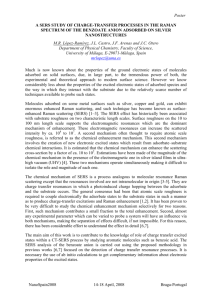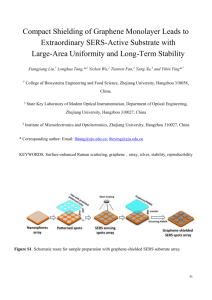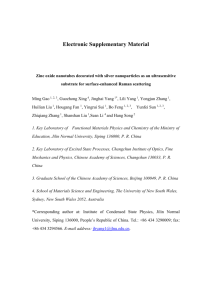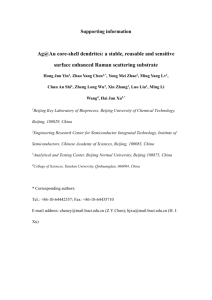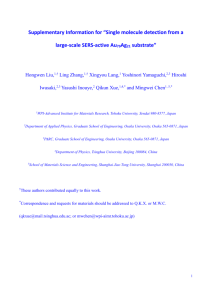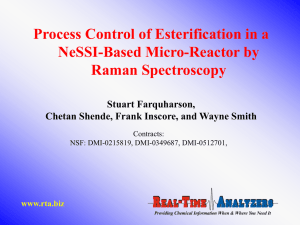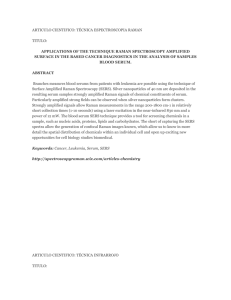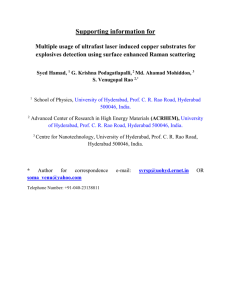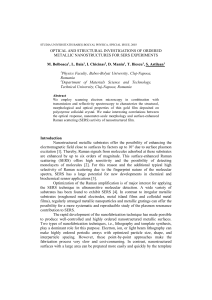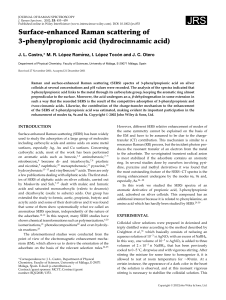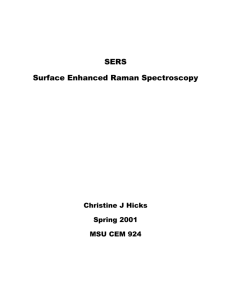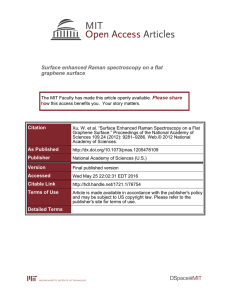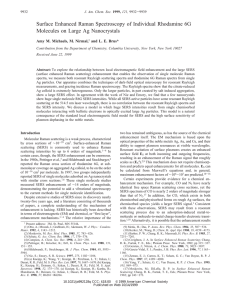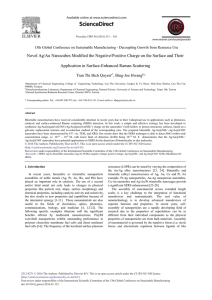Latest Supplementary Material (062107APL)
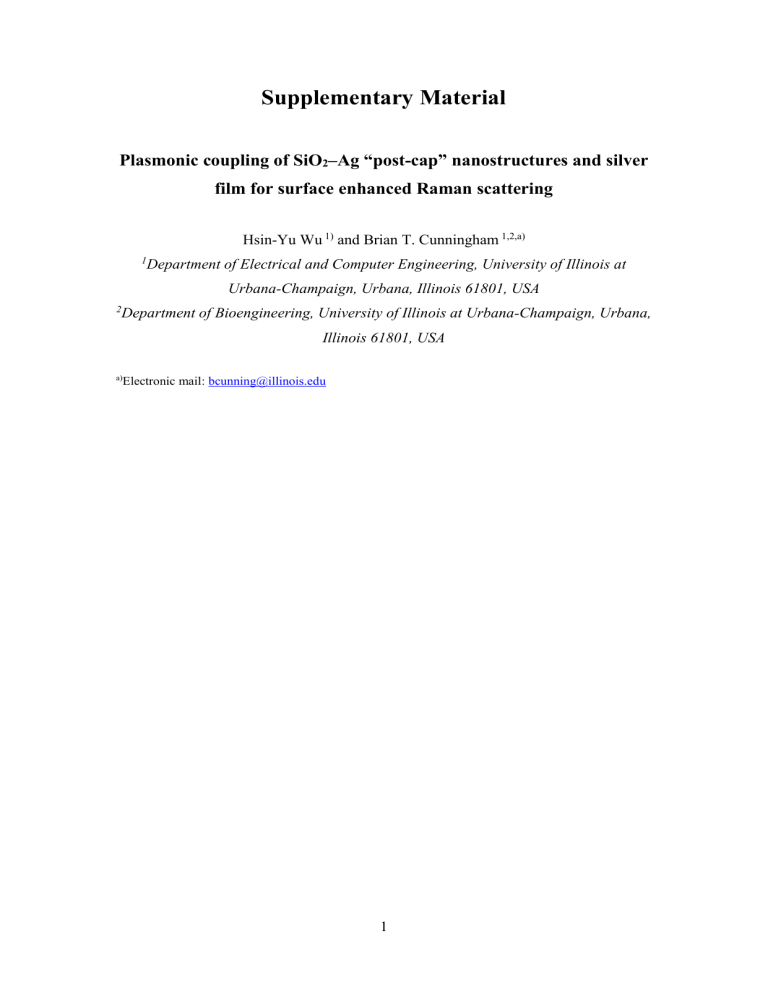
Supplementary Material
Plasmonic coupling of SiO
2
–Ag “post-cap” nanostructures and silver film for surface enhanced Raman scattering
Hsin-Yu Wu 1) and Brian T. Cunningham 1,2,a)
1 Department of Electrical and Computer Engineering, University of Illinois at
Urbana-Champaign, Urbana, Illinois 61801, USA
2
Department of Bioengineering, University of Illinois at Urbana-Champaign, Urbana,
Illinois 61801, USA a) Electronic mail: bcunning@illinois.edu
1
Glancing angle deposition (GLAD) process
For the GLAD process, the slides were first attached to a circular plate equipped with a programmable rotation motor in the electron-beam evaporation system (Temescal) with a deposition rate of 5 Å/s for both materials. The angle between substrate surface and the incoming flux of evaporated material was set to be 5° for self-shadowing and limited surface diffusion. The plate was alternately rotated between 0° and 180° about its normal axis at 10 sec intervals until an in-situ quartz crystal deposition monitor showed that the target SiO
2
post thickness had been reached. Next, the deposition source was switched to a silver crucible, and the same deposition process was performed for creating 30 nm Ag caps to complete the device.
3-D finite-difference time-domain (FDTD) simulation
For 3D modeling simplicity, the SiO
2
post layer was assumed to possess the same cross-sectional area in the x-y plane as the Ag cap layer, and SiO
2 post and Ag cap layer thicknesses are set to be 20 and 30 nm, respectively. The optical properties of
Ag and SiO
2
were taken from Palik’s handbook
1
. Perfectly matched layers are imposed at boundaries of the propagation direction to absorb incident radiation.
Raman instrumentation
SERS spectra were measured by using a Raman microscope equipped with a 17 mW
HeNe laser (λ = 632.8 nm) and a 5x objective (NA = 0.12) (Renishaw inVia), with a measured spot size diameter of 150 µm. The laser power at the exit of the objective is
10.56 µW with an integration time of 20 sec. R6G solution was used as an analyte due to its strong Raman scattering cross section.
2
SERS enhancement factor (EF) calculations
The calculation of the SERS EF for Metal-SERS substrate from experimental measurements is based on the following equation
2
SERS EF
I
SERS
I bulk
(
(
Raman
Raman
)
)
N
SERS
N bulk where I
SERS
(
Raman
) is the SERS intensity at 1363 cm
-1 shift from SERS spectrum of 1
µM R6G on the Metal-SERS substrate,
I bulk
(
Raman
) is the nonenhanced Raman intensity at the 1363 cm
-1 shift from the Raman spectra of 1 mM R6G on the reference sample, N bulk
is the number of R6G molecules within excitation laser spot on the reference sample, N
SERS
is the number of R6G molecules excited by the enhanced electric field within the hot spot region on Metal-SERS substrate. N was calculated bulk by the following equation
3
N bulk
ref A
2 c N d h
4 where c ref
is the molar concentration of the R6G on the reference sample (1 mM),
N
A
is Avogadro’s number, d is the spot size diameter of the excitation laser (150
µm), and h is the thickness of the R6G spot on the reference sample (120 nm). N
SERS was calculated by the following equation 2
N
SERS
cN V
A where c is the molar concentration of the R6G on Metal-SERS substrate (1 µM), N
A is Avogadro’s number, and V is the volume of total hot spots within the excitation laser spot size and was determined from the 3D FDTD simulation. Because the number of hot spot “voxels” (i.e. volume pixels) in the entire simulation area
(290×180 nm 2 ) for Metal-SERS substrate was calculated as 6704 nm 3 , V , the volume of total hot spots within a 150 µm laser spot size, is
3
2
6704 nm 3 .
Therefore, the SERS EF for Metal-SERS substrate within the hot spot regions was calculated to be
9
.
3
Simulated G
SERS
map for Glass-SERS substrate
FIG. S1 Computer-simulated SERS enhancement map of G
SERS
for Glass-SERS substrate with the number of hot spots of 3514 in comparison with 6704 for Metal-
SERS substrate.
References
[S1] E. D. Palik, Handbook of Optical Constants of Solids (Academic, Orlando, FL,
1985).
[S2] Katherine A. Willets and Richard P. Van Duyne, Annual Review of Physical
Chemistry 58 (1), 267 (2007).
[S3] Charles J. Choi, Zhida Xu, Hsin-Yu Wu, Gang Logan Liu, and Brian T.
Cunningham, Nanotechnology 21 (41), 415301 (2010).
4
![[1] M. Fleischmann, P.J. Hendra, A.J. McQuillan, Chem. Phy. Lett. 26](http://s3.studylib.net/store/data/005884231_1-c0a3447ecba2eee2a6ded029e33997e8-300x300.png)
